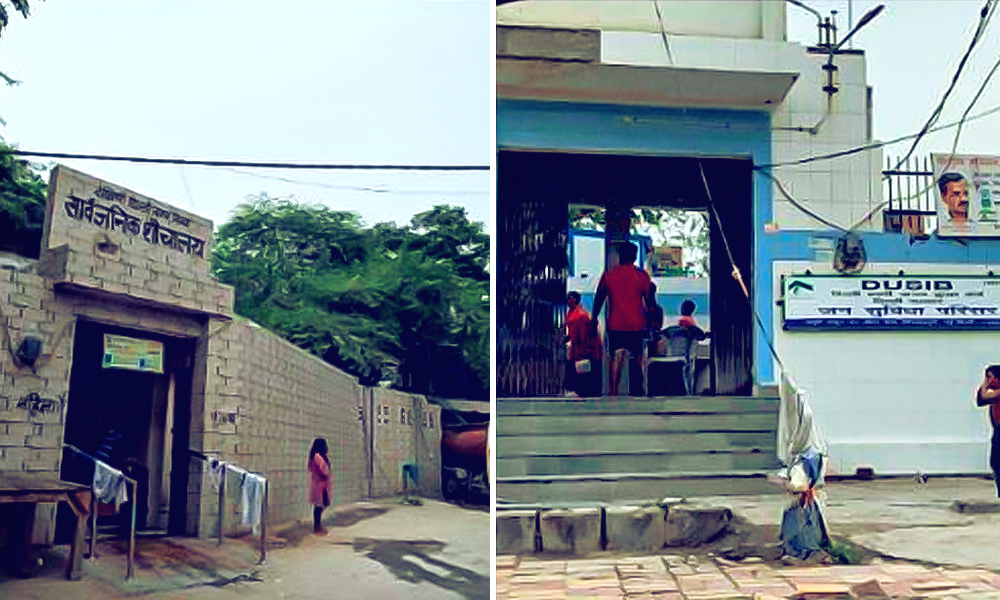
Image Credits: NDTV
95% Of Slum Dwellers In East Delhi Have Access To Toilets: Survey
Writer: Palak Agrawal
Palak a journalism graduate believes in simplifying the complicated and writing about the extraordinary lives of ordinary people. She calls herself a " hodophile" or in layman words- a person who loves to travel.
Delhi, 20 Feb 2021 11:49 AM GMT
Editor : Prateek Gautam |
A free soul who believes that journalism, apart from politics, should stand for social cause and the environment.
Creatives : Rajath
A free spirit who find meaning in life with the virtue of creativity and doing job par its excellence, animal lover and traveller by heart.
In February, teams from the Quality Council of India had randomly inspected 22 toilets and standalone urinals in east Delhi as a third party under the Swachh Survekshan and ranked them on five parameters.
A survey conducted by the East Delhi Municipal Corporation (EDMC) has revealed that 95 per cent of the people in slum areas in east Delhi were using toilets at their homes and merely 5 per cent were opting for public toilets.
According to a report by The Times of India, a senior EDMC official said that the survey was conducted last month with the help of an NGO.
"Since we applied for ODF+ certificate under Swachh Bharat Abhiyan, we did a final survey last month to understand if open defecation is still happening anywhere. With the help of an NGO, the Centre for Urban and Regional Excellence, we conducted the survey at various sites where incidents of open defecation were reported in the past. Their recent findings reveal that only 5% of people in slum areas are using public toilets and the rest have toilets at their homes," the official stated.
Under the central government's Swachh Bharat Mission, the cities were becoming ODF. However, for long term behavioural changes, it was important to sustain and maintain the toilets under the mission. Hence, ODF+ and ODF++ were introduced to scale and direct consistent efforts towards maintenance work. Also, ensure safe collection and treatment of faecal sludge and sewage.
ODF+ (Open Defecation Free+) certificate can be awarded to a city, ward or work circle when not a single person is found defecating and/or urinating in the open at any point of the day, and all the community and public toilets are functioning and properly maintained.
The publication reported that there were 58 community toilets, 26 public toilets and 240 standalone urinals under the municipal corporation. In February, teams from the Quality Council of India had randomly inspected 22 toilets and standalone urinals in east Delhi as a third party under the Swachh Survekshan and ranked them on five parameters.
Reports state that not even one was found unusable or dirty. Of them, five were found clean, 12 very clean and five aspirational.
"We were finally granted ODF+ certificate. Altogether six toilets and 21 standalone urinals were found in the best condition in the QCI survey," the official added.
The NGO that worked in tandem with the authorities claimed to have visited each household to gather necessary data. Teams engaged with the locals and asked basic questions if public toilets were accessible or if they had access to toilets at home.
"At places, we found people had constructed septic tanks also. We later verified the collected data with the area sanitary inspector," said one of the representatives of the NGO.
Action Taken On Previous Surveys
In October, the EDMC had conducted a detailed survey on the areas falling under its jurisdiction. Reportedly, with the help of the same NGO, the survey was conducted to take note of the challenges faced, inspect the existing facilities, maintenance check, presence of attendant and examining the separate facilities meant for use by the children.
Out of the 85 surveyed sites, caretakers were present at 52 places; 83 places (including 29 borewells, 53 DJB pipelines and one tanker) had a water supply, clean urinals at 76 complexes and toilet complexes. Out of 1,226 toilet seat, 85 were found non-operational.
"On the basis of the feedback we received, we beefed up maintenance level, deputed tankers for regular water supply at places where supply lin is not available, connected toilets to sewer lines and deputed staff at each place. Further, we added essential and desirable facilities at 40 complexes, including sanitary vending machines, soap dispensers, dustbins," the official explained.
Toilets In Slum Areas
Slum areas are informal overcrowded settlements within cities unfit for human habitation. Due to lack of space, several issues like regular water supply, sewage treatment and maintenance crop up during construction of toilets in such areas.
A 2020 NDTV report highlighted that although toilets were built in slum areas in the national capital, access to it remained problematic.
The report pointed out that one of major issues faced by such slum dwellers was the distance at which these facilities were located at a distance from most houses and the locals needed to use it at any time of the day.
"Unlike the men living here, we can't relive ourselves as and when we want to, it's not that easy," said 36-year-old Devika, resident of Geeta Colony for about two decades now.
"When it rains or when it is extremely cold, when there is no electricity due to the frequent power cuts in our locality, we have to find other options as the toilets are at least a ten-minute walk," she added.
Over usage has been cited as another serious concern.
"Every day, in the morning as well as in the evening, we have to stand in a long queue for as long as half an hour to use the toilets. Some of us work as domestic helpers or other duties with fixed timings; it gets difficult for us to manage our routine," a resident from one of the slum colonies said.
Also Read: Bengaluru Police Commissioner Orders Action Against Begging At Traffic Signals
 All section
All section














